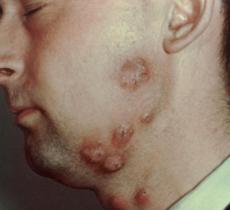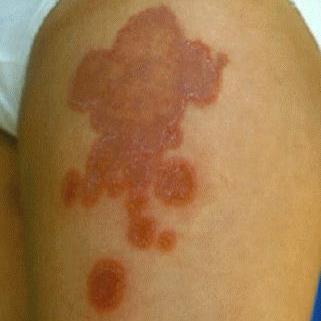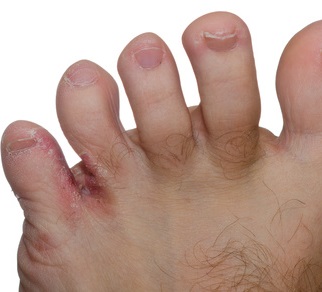
Are you wondering what ringworm looks like? We’ll show you some ringworm photos to help you recognize the condition if you or a family member catches it. Ringworm is highly contagious so it’s important to avoid close physical contact with people that have it and to get treatment for the condition as soon as possible if you do get it. In addition to telling you what ringworm looks like, we’ll tell you what you need to do if you contract the condition.
What Does Ringworm Look Like?
Ringworm usually starts as a patch of scaly skin. Then a raised border develops, which may be round or irregular in shape, resembling a worm (hence the name ringworm). The center may consist of normal-looking skin, scaly skin, or scattered red bumps. Ringworm can be found on any part of the body. There may be just one or two rings, or there may be multiple rings and the rings may overlap. The condition is usually itchy, sometimes very itchy.
Sometimes ringworm appears on the scalp. Then it usually looks like bald patches with crusty or scaly skin. The hair may become brittle and break off at or near the scalp, or it may simply fall out. In some cases, scarring of the scalp occurs, leading to permanent hair loss. In severe cases, the patches of ringworm become swollen and pus drains from them. The condition is painful, sometimes very much so.
Ringworm Photos
Here are some photos so you can see how ringworm often looks on different parts of the body. Notice that while it can vary in appearance, it’s still pretty recognizable. If you have a skin condition and you’re not sure you if it’s ringworm or something else, though, see your doctor for a diagnosis. Different skin conditions require different treatments so it’s important to know what you’re dealing with in order to treat it effectively.
First is a picture of ringworm on the part of the face often covered by a beard, technically known as tinea barbae. When ringworm appears on other areas of the face, it’s known as tinea faciei.

Next are some pictures of ringworm on the body, technically called tinea corporis.
 Ringworm On Leg |  Ringworm On Arm And Shoulder |
You can see how sometimes the rings overlap one another in this picture.

And here is a picture of ringworm of the foot, technically called tinea pedis and often referred to as athlete’s foot. Athlete’s foot is the most common of all types of ringworm and it may be the most persistent, as well. Ringworm can also affect the toenails.

Finally, here are some pictures of ringworm of the scalp, technically referred to as tinea capitis. You can see from these photos how hair loss is common with ringworm of the scalp. In some cases, hair loss can be permanent. Getting a prompt treatment can help prevent that from happening.
 |  |
Treating Ringworm
If you’ve got a skin condition like those shown in these ringworm photos, you probably want to know how to treat it. Ringworm is usually treated with over-the-counter topical medications. Ringworm of the scalp is sometimes treated with prescription shampoo. In severe cases, doctors prescribe oral medications for ringworm, but most of the time, over-the-counter medications do the trick. Talk to your doctor if over-the-counter treatments don’t seem to be helping your condition or if you have questions about the best treatment for you. Keep in mind the fact that it can take a few weeks for ringworm to clear up completely.
Our Preferred Treatment For Ringworm
Our preferred over-the-counter treatment for ringworm is called Phytozine. It contains a medicine called tolnaftate that acts fast to get rid of ringworm, along with a number of natural ingredients like aloe, lavender, and tea tree oil, that work together to relieve the uncomfortable symptoms of ringworm, like itching. To learn more about our preferred remedy for ringworm, just follow the link to the Phytozine Website.
